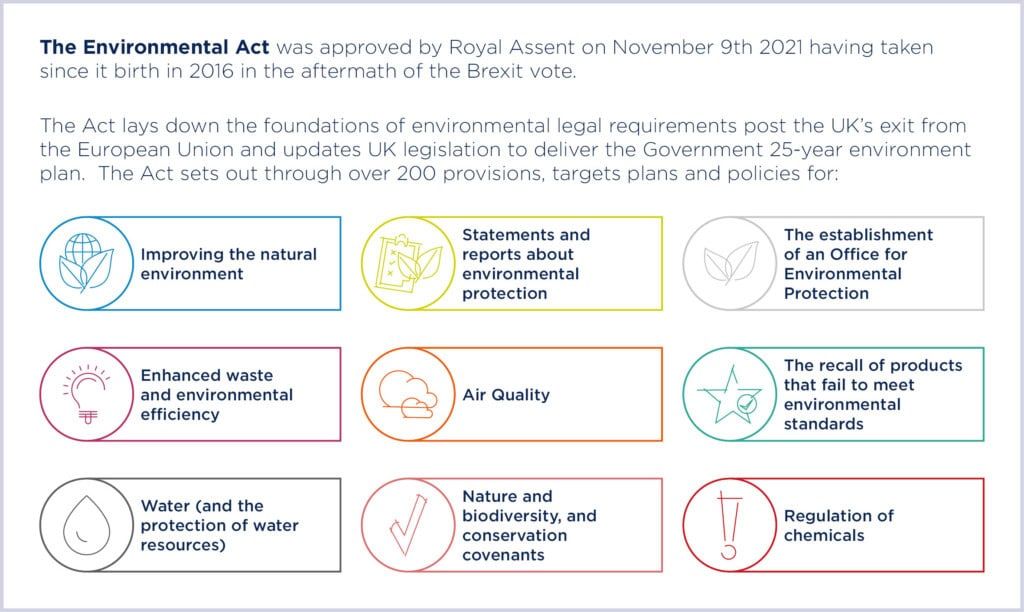The Environmental Act, which came into law at the end of last year, is one of the forthcoming pieces of legislation alongside the recently read Carbon Emissions (Buildings) Bill, that will protect and enhance our environment for future generations to come.
Aiming to clean up the country’s air and water, restore natural habitats, increase biodiversity, reduce waste and make better use of our resources, it is a transformative umbrella piece of legislation. However, at over 250 pages, it is a lot to digest, make sense of and then understand how it will impact the different services, sectors and stakeholders within the built environment.
With sustainability woven into the heart of how RLB operates and on the agenda within every client relationship we have, the Act is an important milestone that will hopefully bring the momentum we need to move the industry to a more sustainable future.
Andrew Thomson, RLB UK’s Environmental Manager discusses a few stand out areas and what they will mean to the construction industry:
Nature and biodiversity
Bringing in a requirement for every development, including major infrastructure projects, to incorporate a 10% uplift or net gain of biodiversity from a baseline of each site will be a gamechanger for those in the built environment. Firstly, it will mean a real understanding of how teams will measure the baseline biodiversity of the sites and the industry working together to produce best practice and standardised metrics. Where on-site net gain in not possible it also calls for design and build teams to work collaboratively to incorporate that 10% into other sites working with wider stakeholders in the community. This brings about opportunities to enhance both natural and social capital, and creation of new jobs and skills, meaning this will be both a challenge and an opportunity.
Waste and Resource efficiency
The ownership of management of waste will also see massive changes with the new legislation that will affect the construction of new buildings and refurbishment of existing estates. Electronic tracking of waste will mean contractors and those involved in the build will be more accountable for the waste from projects and have a higher duty of care to dispose of that waste efficiently and with sustainability in mind. The other dimension is about resource efficiency and driving the circular economy with resources recovered for re-use and recycling and given a second life – this applies to materials and whole buildings and follows a build less, build smarter and build greener ethos.
Air quality and environmental recall
Rightly so, air quality will be a major focus within the Act, especially within urban areas. Our teams at RLB are already working with city councils and local authorities to look at urban centre regeneration and as part of this how cities and towns leaders can zone their spaces to include cleaner air zones, working within the Clean Air Act. Likewise, the introduction of innovative projects like the Cambridgeshire Autonomous Metro (CAM) and the Dudley Metropolitan Borough Council’s innovative Very Light Rail (VLR), both projects that RLB’s infrastructure team are involved with, will help those in charge of city and town centres fulfil their obligations and meet their carbon zone targets.
Public sector clients with old infrastructure and such as hospitals and educational estates are already looking at ways they can decarbonise their estates and commitments such as the Greener NHS: Delivering a net zero NHS strategy will work towards the governance outlined in the Act. At RLB we have been supporting our healthcare clients in creating their Green Plans and adoption greener and more environmental practices both as part of their operational strategies and within their redevelopments with projects such as the one RLB is involved in with the University Hospitals of Leicester NHS Trust.
Water management
One of the most significant changes will be the mitigation and adaption of how we manage water to help alleviate climate change. From the way we use water to build new stock in the housing sector to projects that use sustainable urban drainage systems and are resilient to a changing and increasingly extreme weather driven by climate change. From porous paving to sponge cities – there is a lot to address to help us adapt in terms of reducing demand for water and managing it more effectively.
Sustainability Upskilling
Of course, all of these changes to the way we design and build will need new skill sets in our industry with ecologists and other experts working alongside our project managers, employers agents and the like. Cost managers will need to be upskilled in their understanding of for example what the 10% biodiversity uplift will cost but also how to measure the long-term value of this biodiversity in terms of the social value and long-term environmental gain. At RLB, like many in our industry, we are already on this journey with sustainability woven into our onboarding, our training and our service offering to clients.
The Environmental Act has been a long time coming but will have long standing and far-reaching impact on our estates. Having listened to the call for action from the stakeholders at COP26 last Autumn, now is our time to embrace and implement these measures to build for our future.

FURTHER INFORMATION:


